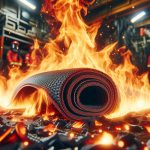You might not know that fire-resistant fabrics today are not only about safety but also designed for comfort and performance. These innovations go beyond just resisting flames; they incorporate lightweight, durable, and flexible materials that can greatly enhance your work efficiency in hazardous environments. Imagine wearing protective gear that feels like regular clothing but offers top-tier protection. Curious about what makes these fabrics so advanced? Let's explore how modern technologies and high-performance blends are setting new standards in protective clothing.
Table of Contents
Key Takeaways
- Inherently flame-retardant fibers like aramid and modacrylic offer permanent, consistent resistance to ignition and combustion.
- Advanced treatment technologies use biodegradable chemicals and nanotechnology to enhance fire resistance and durability sustainably.
- High-performance fabric blends combine durability, comfort, and fire resistance, maintaining integrity under extreme conditions.
- Modern fire-resistant fabrics are lightweight, flexible, and provide superior thermal insulation and chemical resistance.
- Innovations for firefighters feature advanced thermal insulation, moisture management, and breathable designs, enhancing agility and endurance.
Evolution of Fire-Resistant Fabrics
The journey of fire-resistant fabrics began with ancient civilizations using natural materials like wool and asbestos to protect against flames. These early attempts laid the groundwork for future advancements, inspiring generations to innovate and improve.
As you explore the evolution of fire-resistant fabrics, you'll see how fiber innovations have drastically transformed protective gear.
Fast forward to the modern era, and you'll find that technological advancements have revolutionized the field. Synthetic fibers such as aramids and polybenzimidazole (PBI) have emerged, offering superior flame resistance and durability. These fibers aren't just resistant to fire; they also provide added benefits like thermal insulation and chemical resistance, making them indispensable in protective gear advancements.
Consider the development of firefighter uniforms. Early gear was heavy and cumbersome, offering limited protection. Today's fire-resistant fabrics are lightweight, flexible, and far more effective, thanks to the continuous improvement in fiber technologies. The same can be said for military and industrial applications, where advanced fabrics provide critical protection in hazardous environments.
Inherently Flame-Retardant Fibers
When you're exploring fire-resistant fabrics, inherently flame-retardant fibers stand out due to their unique chemical composition. These fibers offer unmatched benefits like enhanced safety and performance.
Plus, they provide superior durability and longevity compared to treated alternatives.
Chemical Composition Benefits
Why do inherently flame-retardant fibers offer superior protection against fire hazards?
The secret lies in their chemical composition, which ensures that the fibers themselves are resistant to ignition and combustion. Unlike treated fabrics that rely on external coatings, these fibers are engineered at a molecular level to provide enhanced performance advantages. This intrinsic flame resistance is permanent and doesn't wash out or degrade over time, guaranteeing consistent protection.
You'll appreciate how fabric technology has evolved to integrate these advanced safety features into protective clothing.
Inherently flame-retardant fibers like aramid and modacrylic deliver reliable fire resistance, making them ideal for high-risk environments. These fabrics don't just resist flames; they also self-extinguish, minimizing the risk of injury and property damage.
Moreover, the chemical composition of these fibers contributes to their lightweight and breathable nature, which doesn't compromise comfort for safety.
This balance is vital for professionals who need to remain agile and focused under hazardous conditions. So, when you're looking for protective clothing that offers maximum safety, understanding the benefits of inherently flame-retardant fibers will empower you to make informed decisions that prioritize both performance and protection.
Durability and Longevity
You'll find that inherently fire-resistant fibers boast exceptional strength and longevity, providing consistent protection throughout their lifespan. Unlike chemically treated fabrics, these fibers maintain their fire-resistant properties through countless washes and wears. This inherent quality means you won't have to worry about the protective capabilities diminishing over time.
Understanding the longevity challenges of protective clothing is vital for ensuring safety. Inherently fire-resistant fibers address these challenges by integrating the flame-resistant properties at a molecular level. This integration guarantees that the fabric remains resilient against wear and tear, even under extreme conditions. You're investing in a material designed to withstand rigorous environments without compromising safety.
Durability testing is crucial to validate these claims. When you examine the results, you'll notice that inherently fire-resistant fibers outperform many alternatives. Tests include simulations of prolonged exposure to heat, mechanical stress, and repeated laundering. These tests confirm the material's ability to retain its structural integrity and protective qualities over time.
Ultimately, choosing inherently fire-resistant fibers means prioritizing long-term safety and reliability. You'll benefit from a fabric that not only meets but exceeds industry standards, making it an indispensable component of high-quality protective clothing.
Advanced Treatment Technologies
You'll find that advanced treatment technologies are revolutionizing fire-resistant fabrics.
Chemical treatment advancements, nanotechnology in fabric coating, and heat-resistant polymer blends are leading the charge.
Chemical Treatment Advancements
In recent years, chemical treatment advancements have greatly enhanced the fire resistance of fabrics. By focusing on eco-friendly solutions and sustainable practices, these innovations not only improve safety but also reduce environmental impact. You'll find that modern treatments incorporate biodegradable chemicals that don't compromise the material's durability or comfort.
Additionally, cost-effective options have emerged, making it easier for industries to adopt these advanced treatments without breaking the bank. These solutions meet and often exceed industry standards, ensuring that the protective clothing you invest in is both high-quality and financially viable.
One of the most notable advancements is the development of flame retardants derived from natural sources. These retardants can be applied during the fabric's finishing process, offering a robust layer of protection without adding significant weight or altering the texture. You can confidently choose these advanced chemically treated fabrics, knowing they provide excellent fire resistance while supporting sustainability.
Moreover, the industry is moving towards treatments that last longer, reducing the need for frequent reapplication and further lowering costs and environmental impact. Embracing these innovations helps you stay ahead in a field where safety and sustainability are paramount.
Nanotechnology in Fabric Coating
Nanotechnology revolutionizes fabric coating by providing unparalleled fire resistance and durability. By embedding nanoparticles into textile fibers, you achieve enhanced protection without compromising comfort. These tiny particles create a barrier that's both heat-resistant and durable, ensuring that the fabric can withstand high temperatures and resist ignition effectively.
One of the greatest advantages of nanotechnology in fabric coating is its ability to provide sustainable solutions. Unlike traditional methods that often involve harmful chemicals, nanotechnology uses eco-friendly processes. This approach not only protects the wearer but also minimizes environmental impact.
Here's a comparison table to help you understand the benefits of nanotechnology in fabric coating:
| Feature | Traditional Methods | Nanotechnology |
|---|---|---|
| Fire Resistance | Moderate | High |
| Durability | Low to Moderate | High |
| Environmental Impact | High due to chemicals | Low, eco-friendly processes |
Heat-resistant Polymer Blends
Building on the advancements in fabric technology, heat-resistant polymer blends offer a powerful solution for enhancing the fire resistance of textiles. When you explore the intricacies of polymer design, you'll find that the combination of specific polymers can greatly improve thermal performance. By selecting polymers with inherent flame-retardant properties and blending them in ideal proportions, you can create fabrics that withstand high temperatures without compromising flexibility or comfort.
In mastering this technology, focus on the science behind the polymers. For instance, incorporating aramid fibers or phenolic resins into your blends can yield fabrics that self-extinguish when exposed to flames. This advanced polymer design not only enhances fire resistance but also improves the longevity of the material, making it ideal for protective clothing in high-risk environments.
Furthermore, understanding the thermal performance of these blends is vital. You should evaluate how these materials behave under different heat conditions, ensuring they provide consistent protection. By leveraging advanced treatment technologies, you can engineer fabrics that not only meet but surpass industry standards for fire resistance. This strategic approach positions you at the forefront of innovation in protective clothing.
High-Performance Fabric Blends
High-performance textile blends combine durability and fire resistance, making them ideal for various applications. These advanced materials don't just offer protection; they also guarantee comfort and performance.
Thanks to fabric technology advancements, you can now benefit from fabrics that provide exceptional heat protection without compromising on flexibility or breathability. Whether you're outfitting firefighters, industrial workers, or military personnel, these high-performance blends are designed to meet rigorous standards.
When you consider the significance of heat protection, it's evident that durability enhancements are critical. High-performance fabric blends excel in maintaining their integrity under extreme conditions, thereby extending the lifespan of protective clothing.
Innovations in these fabrics often involve combining materials like aramid fibers and flame-retardant treatments, resulting in a superior product that can withstand high temperatures and resist wear and tear.
Moreover, these fabric blends integrate characteristics that improve user experience. Comfort and performance are paramount, and advancements have led to lighter, more breathable fabrics that don't compromise protection.
Enhancing Durability and Comfort
When enhancing durability and comfort in fire-resistant fabrics, focusing on the balance between strong material durability and user-friendly features is vital. Comfort innovations play a pivotal role in achieving this equilibrium.
You should prioritize fabrics that incorporate breathable designs to keep wearers cool and dry, even in challenging environments. These breathable designs allow for improved air circulation, reducing the risk of heat stress and guaranteeing that the wearer remains comfortable for extended periods.
Regarding longevity improvements, you need to select materials that withstand repeated wear and harsh conditions without compromising their protective qualities. Modern advancements have led to the development of fabrics with enhanced flexibility, which allows for a wider range of motion without sacrificing durability.
This flexibility ensures that the protective clothing moves seamlessly with the wearer, reducing fatigue and enhancing overall performance.
Applications in Industrial Safety
In industrial safety, fire-resistant fabrics play a pivotal role in safeguarding workers from potential fire hazards and extreme conditions. You'll find these fabrics in various workplace applications, including oil and gas, electrical, and chemical industries. These high-risk environments mandate strict safety regulations, making the use of fire-resistant materials not just a recommendation but a necessity.
Advanced fabric technology has greatly elevated the standards of protective clothing. Modern fire-resistant fabrics integrate cutting-edge solutions to meet and surpass industry standards. You can rely on these fabrics to provide durability, comfort, and, most importantly, an exceptional level of safety.
Fabrics such as aramids, treated cotton, and inherently flame-resistant fibers are engineered to withstand high temperatures and resist ignition, ensuring that workers have the best possible protection.
When selecting fire-resistant clothing, it's crucial to prioritize compliance with safety regulations like NFPA 2112 and OSHA standards. These regulations guide you in choosing the appropriate protective gear that meets the strict requirements of your specific industry. By investing in fire-resistant fabrics that adhere to these standards, you're not only ensuring compliance but also maximizing the safety and well-being of your workforce.
Innovations for Firefighters
With advancements in fabric technology, firefighters now have access to innovative fire-resistant materials that offer unprecedented levels of protection and comfort. Modern protective clothing incorporates advanced thermal insulation, guaranteeing you can withstand extreme heat without compromising mobility. These fabrics are designed to provide a barrier between you and the intense temperatures encountered during firefighting, greatly reducing the risk of burns and other heat-related injuries.
Not only do these materials excel in thermal insulation, but they also feature superior moisture management. When you're battling fires, staying dry is vital for maintaining both comfort and effectiveness. Innovative moisture-wicking technologies integrated into these fabrics pull sweat away from your skin, keeping you dry and reducing the risk of heat stress. This dual-functionality guarantees you can stay focused and perform at your best, even in the most challenging conditions.
Furthermore, these state-of-the-art fabrics are lightweight and breathable, enhancing your overall agility and endurance on the job. With these advancements, you're not just protected; you're empowered to face the dangers of firefighting with greater confidence and efficiency. By embracing these cutting-edge innovations, you can secure maximum safety and performance in every mission.
Future Trends in Protective Textiles
Emerging technologies promise to revolutionize protective textiles, offering even greater safety and functionality for those on the front lines. As someone who values mastery in your field, you'll appreciate the focus on sustainability concerns and performance enhancements in the latest developments.
New materials are being engineered to not only withstand extreme conditions but also reduce environmental impact. These innovations include biodegradable fibers and recyclable materials, ensuring your gear remains high-performing while being eco-friendly.
Moreover, performance enhancements aren't limited to just fire-resistance. Advances in fabric technology are integrating moisture-wicking properties, enhanced breathability, and even smart textiles that monitor essential signs. These improvements ensure you stay comfortable and protected, no matter the situation.
Design aesthetics are also evolving to meet modern demands. You don't have to sacrifice style for functionality. Contemporary protective clothing now offers sleek, ergonomic designs that allow for greater freedom of movement, making your tasks easier and safer.
Eco-friendly options are also gaining traction, marrying sustainability with cutting-edge design.
Frequently Asked Questions
How Do Fire-Resistant Fabrics Impact the Environment?
You're wondering about fire-resistant fabrics' environmental impact. These materials often use chemicals that can harm ecosystems. However, recycling options are improving, reducing waste and promoting sustainability in protective clothing. Make eco-friendly choices where possible.
Are Fire-Resistant Fabrics Washable and How Should They Be Maintained?
Ironically, fire-resistant fabrics are durable but demand your delicate touch. Follow specific washing instructions to maintain fabric durability. Avoid harsh detergents, bleach, and high heat to guarantee your protective gear remains effective and long-lasting.
What Certifications Do Fire-Resistant Fabrics Need to Meet?
To verify fire-resistant fabrics meet safety standards, they must undergo rigorous fabric testing. Look for certifications like NFPA 2112 and ASTM F1506. These standards guarantee reliable protection and demonstrate the fabric's adherence to stringent safety protocols.
Can Fire-Resistant Fabrics Be Customized for Specific Industries?
Absolutely, fire-resistant fabrics can be the chameleons of protective clothing. They can be tailored to meet the specific requirements of any industry, incorporating customized designs that guarantee both safety and functionality in specialized environments.
How Does the Cost of Fire-Resistant Fabrics Compare to Regular Fabrics?
When comparing costs, fire-resistant fabrics are generally more expensive than regular fabrics. However, you'll find that the added durability benefits often outweigh the initial investment, making them a cost-effective choice for long-term use.
- Tetron Fabric for Marine Applications: Durability and Use Cases - June 18, 2025
- Tetron Fabric for Outdoor Furniture: Weather Resistance and Care - June 18, 2025
- Tetron Fabric for Wall Coverings: Style and Application Tips - June 18, 2025







